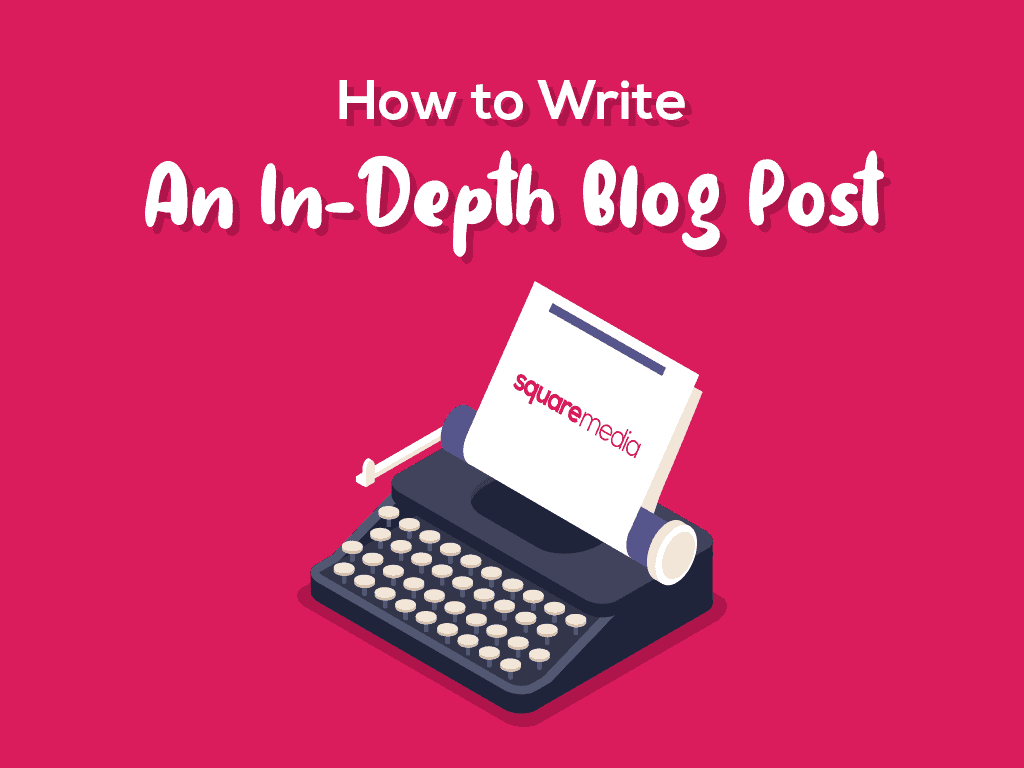
How To Write An In-Depth Blog Post
You want to write great articles, and your website visitors want to read highly informative, entertaining and educational content. You might have your standard 500-word blog post nailed down, but how do you get started with creating an in-depth, comprehensive guide to your topic of choice? Here are some pointers for creating long-form articles that position you as an expert in your field and leave your audience keen to buy from you.
Make a promise in the title and stick to it
Your title doesn’t need to be the first thing you write, and for ease and faster writing, there is a good argument for why it shouldn’t be the first thing you do. But I wanted to raise it early because I think it’s important that whether your blog post is a quick run-down of the basics or a comprehensive guide, the title reflects that. A reader wants to know what they’re getting into. That’s why lots of websites now tell you how long it’s going to take you to read something. Is it a quick two-minute skim or more like poring over the screen for fifteen minutes, notepad at the ready for when inspiration strikes? Both long-form and short content has its benefits and they are both great ways to approach a subject. You could even create both content types when writing about the same thing. Let’s make up an example – a travel agent wants to write articles to promote holidays to Florida. Anyone who has been to Orlando will likely agree there can be an awful lot or just a little planning involved with a theme park holiday, depending on what you’d like to do. As a travel agent, you could write a quick 500-word overview of the activities available in Orlando, whetting someone’s appetite by explaining why they may want to go there. You could also write a 2,000 word article explaining all the ins and outs of Disney theme parks, ticket types, hotels and resorts, restaurants, transportation, and more. In fact, you could even write 2,000 words on every one of those subjects and still have plenty left to say at the end. Your quick guide to Orlando could be titled “A Whistle-Stop Tour of Orlando’s Highlights”, and your longer piece could be “Your Complete Guide To Disney World Hotels”. If you simply call your hotel guide “Which Disney Hotel Should You Stay At?” sure, it tells readers what the blog will be about, but labelling it as a “comprehensive guide” could really attract people looking for some in-depth knowledge.
Consider what your reader wants to know
No matter how long your content is, it’s a good idea to map out what you want to say before recklessly bashing at a keyboard. That’s how I wrote this blog post – I wrote out all of my headings and then filled in the paragraphs for each one. When you’re writing long-form content, it’s especially useful to figure out what you’re going to say before you say it, and headings will both keep you on track and allow the reader to skim or jump to the part they particularly want to read.
So, consider who you are writing for and what you think they want to know. Sticking with our example of writing about Disney hotels, our fictional travel agent would know that there are three tiers to Disney hotels – value, moderate, and deluxe. Each one of those could lend themselves to a separate blog post, but maybe the travel agent knows that their target audience are more likely to be interested in the moderate resorts, rather than the much more expensive deluxe hotels.
Once you know generally what you want to write about, put yourself in the reader’s shoes and imagine you don’t know anything about the topic. What would you want to cover? In this case, think price points, hotel locations, transportation links, restaurants, facilities, and unique resort benefits.
Cover the fundamentals before going deeper
If you’re writing an in-depth blog post on a topic you’re an expert in, it can be easy to start thinking about the more, well, in-depth bits straight away. But remember that your reader may not have the foundational knowledge that you have, and it’s often important to lay out the basics before diving into the more complicated stuff. Don’t assume too much knowledge from your reader. Regular Disney visitors have all sorts of abbreviations they use – DDP is Disney Dining Plan, AKL is Animal Kingdom Lodge, DVC is Disney Vacation Club, and so on. So as you’re writing, make sure you explain any acronyms or jargon, or avoid using them at all if appropriate. Going back to mapping out your blog post before you write, a good first heading is “What is [topic]?” Or “What Are The [Topic] Options?” In the case of our travel agent’s hotel blog, a first heading might be “Where Can You Stay In Disney World?” This introductory paragraph could explain the three tiers of resorts, the general differences between them, and then list the moderate resorts available.
Write at the level of your target audience
While we’re on the subject of knowing your audience and covering the fundamentals before digging into the details, it’s worth reiterating the importance of writing at the right level for your target audience. For example, a blog post designed to introduce someone to a Disney holiday – way at the top of the sales funnel – shouldn’t be littered with acronyms or assume any level of knowledge from the reader. Conversely, you could be writing about new changes to Genie+, Disney’s app used for getting onto rides, ordering food at restaurants via your mobile, and generally planning your holiday. This subject assumes some level of knowledge from the reader because if they are reading about new changes, chances are they already know what Genie+ is, so it could be a little patronising or simply “off” to explain to them what Genie+ is in great detail. Of course, you could cover the fundamentals as we’ve said before, but this could be done in a sentence or two and may be setting the scene for recent changes rather than explaining the basics the reader is likely to already know. You could also provide links to your previous blog posts that people could follow and read if they realise they need further background information.
Know your stuff, and do your research if you don’t
As writers, sometimes we can sit down and churn out a blog post in an hour without using any resources at all, because we know the subject so well. And sometimes it will take hours to get the thing down because it’s not something we’re an expert in and we need to do a lot of research in order to do a good job. This is even more likely to be the case when we’re writing an in-depth blog post because it’s generally longer, more information is needed, and it may be on a niche subject with more granular detail. If you already know everything about what you’re writing, that’s great, but if you don’t, it’s important to research well in order to do your article justice. Be sure to factor in time for this work.
Use reputable sources
If you do need to do research, make sure you’re using reputable sources. Consider official websites, news outlets, journals, or talk to colleagues who may be able to help you. Writing an in-depth blog post isn’t just about the length of the thing and how much information it provides, but the quality and trustworthiness of that information.
Link to further reading
To help increase your trustworthiness and ensure your article comes across as reputable, it’s a good idea to link to further reading. This is especially true if you’re providing statistics or facts from another website – a simple link within the text can show a reader where you found your information so they know you’re not pulling anything out of the air or stating opinions as facts. This should go hand-in-hand with your further research. It’s also good for your SEO if you’re linking to reputable sources. And of course, and in-depth blog post isn’t in-depth just because of the text on that page – it can go beyond itself by giving readers other content to look at, making it even more comprehensive.
Link to your other great educational or informative content
Don’t just leave your audience wanting more – give them more. While linking to other websites is great, blog posts also offer a great opportunity to link to your other content. Again, this is a great opportunity to provide further reading and in-depth information. It also positions you as an expert in your field, and it’s even better than linking to other websites because it keeps people on your site. It works especially well when your content is all aligned. This may be because you’ve created a blog series that takes a reader through a whole journey, or it may be because you’ve created a wealth of information on your blog covering as many aspects of your offering or field as you can think of, and you’ve continuously identified gaps where you can slot in more great informative, educational, and entertaining content. For our travel agent, they could ensure they have written blog posts about Disney hotels in general, a general overview of each hotel tier, and a blog post about every individual hotel. These could all link to each other in the text where appropriate. Remember: the more helpful information you provide to a potential customer, the more likely they are to buy from you than a competitor who hasn’t gone that extra mile. And it all helps with your SEO as well as giving you more content to share on your social media channels and in your email marketing.
If you would like any help with your website content, get in touch with Square Media. Our dedicated content team will be happy to assist you with forming a strategy, finding ideas and writing blog posts your readers will love.

